Yucong Luo
DARTS: A Dual-View Attack Framework for Targeted Manipulation in Federated Sequential Recommendation
Jul 02, 2025Abstract:Federated recommendation (FedRec) preserves user privacy by enabling decentralized training of personalized models, but this architecture is inherently vulnerable to adversarial attacks. Significant research has been conducted on targeted attacks in FedRec systems, motivated by commercial and social influence considerations. However, much of this work has largely overlooked the differential robustness of recommendation models. Moreover, our empirical findings indicate that existing targeted attack methods achieve only limited effectiveness in Federated Sequential Recommendation(FSR) tasks. Driven by these observations, we focus on investigating targeted attacks in FSR and propose a novel dualview attack framework, named DV-FSR. This attack method uniquely combines a sampling-based explicit strategy with a contrastive learning-based implicit gradient strategy to orchestrate a coordinated attack. Additionally, we introduce a specific defense mechanism tailored for targeted attacks in FSR, aiming to evaluate the mitigation effects of the attack method we proposed. Extensive experiments validate the effectiveness of our proposed approach on representative sequential models. Our codes are publicly available.
Benchmarking Multimodal LLMs on Recognition and Understanding over Chemical Tables
Jun 13, 2025Abstract:Chemical tables encode complex experimental knowledge through symbolic expressions, structured variables, and embedded molecular graphics. Existing benchmarks largely overlook this multimodal and domain-specific complexity, limiting the ability of multimodal large language models to support scientific understanding in chemistry. In this work, we introduce ChemTable, a large-scale benchmark of real-world chemical tables curated from the experimental sections of literature. ChemTable includes expert-annotated cell polygons, logical layouts, and domain-specific labels, including reagents, catalysts, yields, and graphical components and supports two core tasks: (1) Table Recognition, covering structure parsing and content extraction; and (2) Table Understanding, encompassing both descriptive and reasoning-oriented question answering grounded in table structure and domain semantics. We evaluated a range of representative multimodal models, including both open-source and closed-source models, on ChemTable and reported a series of findings with practical and conceptual insights. Although models show reasonable performance on basic layout parsing, they exhibit substantial limitations on both descriptive and inferential QA tasks compared to human performance, and we observe significant performance gaps between open-source and closed-source models across multiple dimensions. These results underscore the challenges of chemistry-aware table understanding and position ChemTable as a rigorous and realistic benchmark for advancing scientific reasoning.
Time Series Forecasting as Reasoning: A Slow-Thinking Approach with Reinforced LLMs
Jun 12, 2025Abstract:To advance time series forecasting (TSF), various methods have been proposed to improve prediction accuracy, evolving from statistical techniques to data-driven deep learning architectures. Despite their effectiveness, most existing methods still adhere to a fast thinking paradigm-relying on extracting historical patterns and mapping them to future values as their core modeling philosophy, lacking an explicit thinking process that incorporates intermediate time series reasoning. Meanwhile, emerging slow-thinking LLMs (e.g., OpenAI-o1) have shown remarkable multi-step reasoning capabilities, offering an alternative way to overcome these issues. However, prompt engineering alone presents several limitations - including high computational cost, privacy risks, and limited capacity for in-depth domain-specific time series reasoning. To address these limitations, a more promising approach is to train LLMs to develop slow thinking capabilities and acquire strong time series reasoning skills. For this purpose, we propose Time-R1, a two-stage reinforcement fine-tuning framework designed to enhance multi-step reasoning ability of LLMs for time series forecasting. Specifically, the first stage conducts supervised fine-tuning for warmup adaptation, while the second stage employs reinforcement learning to improve the model's generalization ability. Particularly, we design a fine-grained multi-objective reward specifically for time series forecasting, and then introduce GRIP (group-based relative importance for policy optimization), which leverages non-uniform sampling to further encourage and optimize the model's exploration of effective reasoning paths. Experiments demonstrate that Time-R1 significantly improves forecast performance across diverse datasets.
Molar: Multimodal LLMs with Collaborative Filtering Alignment for Enhanced Sequential Recommendation
Dec 24, 2024Abstract:Sequential recommendation (SR) systems have evolved significantly over the past decade, transitioning from traditional collaborative filtering to deep learning approaches and, more recently, to large language models (LLMs). While the adoption of LLMs has driven substantial advancements, these models inherently lack collaborative filtering information, relying primarily on textual content data neglecting other modalities and thus failing to achieve optimal recommendation performance. To address this limitation, we propose Molar, a Multimodal large language sequential recommendation framework that integrates multiple content modalities with ID information to capture collaborative signals effectively. Molar employs an MLLM to generate unified item representations from both textual and non-textual data, facilitating comprehensive multimodal modeling and enriching item embeddings. Additionally, it incorporates collaborative filtering signals through a post-alignment mechanism, which aligns user representations from content-based and ID-based models, ensuring precise personalization and robust performance. By seamlessly combining multimodal content with collaborative filtering insights, Molar captures both user interests and contextual semantics, leading to superior recommendation accuracy. Extensive experiments validate that Molar significantly outperforms traditional and LLM-based baselines, highlighting its strength in utilizing multimodal data and collaborative signals for sequential recommendation tasks. The source code is available at https://anonymous.4open.science/r/Molar-8B06/.
TextMatch: Enhancing Image-Text Consistency Through Multimodal Optimization
Dec 24, 2024Abstract:Text-to-image generative models excel in creating images from text but struggle with ensuring alignment and consistency between outputs and prompts. This paper introduces TextMatch, a novel framework that leverages multimodal optimization to address image-text discrepancies in text-to-image (T2I) generation and editing. TextMatch employs a scoring strategy powered by large language models (LLMs) and visual question-answering (VQA) models to evaluate semantic consistency between prompts and generated images. By integrating multimodal in-context learning and chain of thought reasoning, our method dynamically refines prompts through iterative optimization. This process ensures that the generated images better capture user intent of, resulting in higher fidelity and relevance. Extensive experiments demonstrate that TextMatch significantly improves text-image consistency across multiple benchmarks, establishing a reliable framework for advancing the capabilities of text-to-image generative models. Our code is available at https://anonymous.4open.science/r/TextMatch-F55C/.
Hierarchical Multimodal LLMs with Semantic Space Alignment for Enhanced Time Series Classification
Oct 24, 2024



Abstract:Leveraging large language models (LLMs) has garnered increasing attention and introduced novel perspectives in time series classification. However, existing approaches often overlook the crucial dynamic temporal information inherent in time series data and face challenges in aligning this data with textual semantics. To address these limitations, we propose HiTime, a hierarchical multi-modal model that seamlessly integrates temporal information into LLMs for multivariate time series classification (MTSC). Our model employs a hierarchical feature encoder to capture diverse aspects of time series data through both data-specific and task-specific embeddings. To facilitate semantic space alignment between time series and text, we introduce a dual-view contrastive alignment module that bridges the gap between modalities. Additionally, we adopt a hybrid prompting strategy to fine-tune the pre-trained LLM in a parameter-efficient manner. By effectively incorporating dynamic temporal features and ensuring semantic alignment, HiTime enables LLMs to process continuous time series data and achieves state-of-the-art classification performance through text generation. Extensive experiments on benchmark datasets demonstrate that HiTime significantly enhances time series classification accuracy compared to most competitive baseline methods. Our findings highlight the potential of integrating temporal features into LLMs, paving the way for advanced time series analysis. The code is publicly available for further research and validation. Our codes are publicly available1.
Learning Recommender Systems with Soft Target: A Decoupled Perspective
Oct 09, 2024



Abstract:Learning recommender systems with multi-class optimization objective is a prevalent setting in recommendation. However, as observed user feedback often accounts for a tiny fraction of the entire item pool, the standard Softmax loss tends to ignore the difference between potential positive feedback and truly negative feedback. To address this challenge, we propose a novel decoupled soft label optimization framework to consider the objectives as two aspects by leveraging soft labels, including target confidence and the latent interest distribution of non-target items. Futhermore, based on our carefully theoretical analysis, we design a decoupled loss function to flexibly adjust the importance of these two aspects. To maximize the performance of the proposed method, we additionally present a sensible soft-label generation algorithm that models a label propagation algorithm to explore users' latent interests in unobserved feedback via neighbors. We conduct extensive experiments on various recommendation system models and public datasets, the results demonstrate the effectiveness and generality of the proposed method.
DV-FSR: A Dual-View Target Attack Framework for Federated Sequential Recommendation
Sep 10, 2024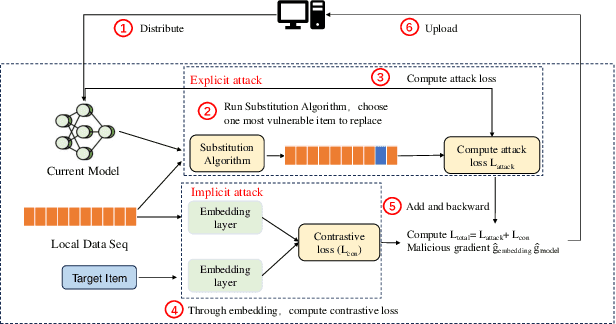
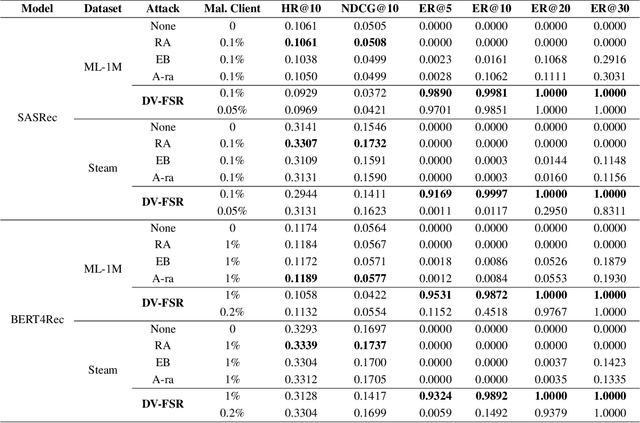

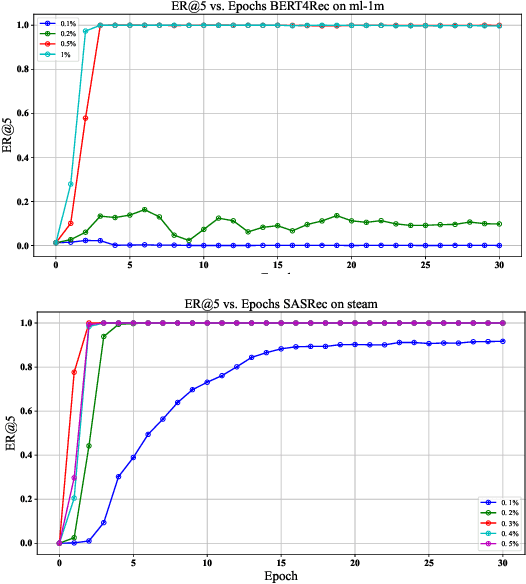
Abstract:Federated recommendation (FedRec) preserves user privacy by enabling decentralized training of personalized models, but this architecture is inherently vulnerable to adversarial attacks. Significant research has been conducted on targeted attacks in FedRec systems, motivated by commercial and social influence considerations. However, much of this work has largely overlooked the differential robustness of recommendation models. Moreover, our empirical findings indicate that existing targeted attack methods achieve only limited effectiveness in Federated Sequential Recommendation (FSR) tasks. Driven by these observations, we focus on investigating targeted attacks in FSR and propose a novel dualview attack framework, named DV-FSR. This attack method uniquely combines a sampling-based explicit strategy with a contrastive learning-based implicit gradient strategy to orchestrate a coordinated attack. Additionally, we introduce a specific defense mechanism tailored for targeted attacks in FSR, aiming to evaluate the mitigation effects of the attack method we proposed. Extensive experiments validate the effectiveness of our proposed approach on representative sequential models.
Advancing Time Series Classification with Multimodal Language Modeling
Mar 19, 2024

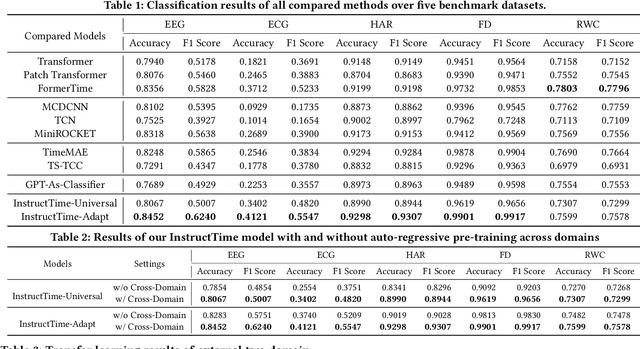
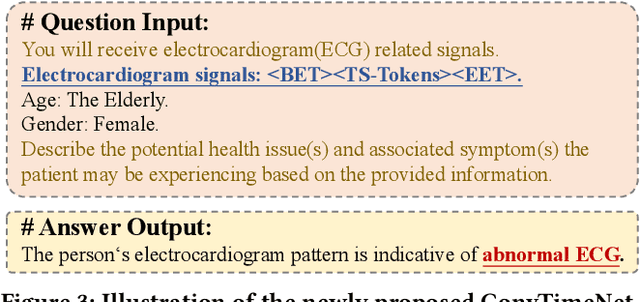
Abstract:For the advancements of time series classification, scrutinizing previous studies, most existing methods adopt a common learning-to-classify paradigm - a time series classifier model tries to learn the relation between sequence inputs and target label encoded by one-hot distribution. Although effective, this paradigm conceals two inherent limitations: (1) encoding target categories with one-hot distribution fails to reflect the comparability and similarity between labels, and (2) it is very difficult to learn transferable model across domains, which greatly hinder the development of universal serving paradigm. In this work, we propose InstructTime, a novel attempt to reshape time series classification as a learning-to-generate paradigm. Relying on the powerful generative capacity of the pre-trained language model, the core idea is to formulate the classification of time series as a multimodal understanding task, in which both task-specific instructions and raw time series are treated as multimodal inputs while the label information is represented by texts. To accomplish this goal, three distinct designs are developed in the InstructTime. Firstly, a time series discretization module is designed to convert continuous time series into a sequence of hard tokens to solve the inconsistency issue across modal inputs. To solve the modality representation gap issue, for one thing, we introduce an alignment projected layer before feeding the transformed token of time series into language models. For another, we highlight the necessity of auto-regressive pre-training across domains, which can facilitate the transferability of the language model and boost the generalization performance. Extensive experiments are conducted over benchmark datasets, whose results uncover the superior performance of InstructTime and the potential for a universal foundation model in time series classification.
Generative Pretrained Hierarchical Transformer for Time Series Forecasting
Feb 26, 2024



Abstract:Recent efforts have been dedicated to enhancing time series forecasting accuracy by introducing advanced network architectures and self-supervised pretraining strategies. Nevertheless, existing approaches still exhibit two critical drawbacks. Firstly, these methods often rely on a single dataset for training, limiting the model's generalizability due to the restricted scale of the training data. Secondly, the one-step generation schema is widely followed, which necessitates a customized forecasting head and overlooks the temporal dependencies in the output series, and also leads to increased training costs under different horizon length settings. To address these issues, we propose a novel generative pretrained hierarchical transformer architecture for forecasting, named GPHT. There are two aspects of key designs in GPHT. On the one hand, we advocate for constructing a mixed dataset for pretraining our model, comprising various datasets from diverse data scenarios. This approach significantly expands the scale of training data, allowing our model to uncover commonalities in time series data and facilitating improved transfer to specific datasets. On the other hand, GPHT employs an auto-regressive forecasting approach under the channel-independent assumption, effectively modeling temporal dependencies in the output series. Importantly, no customized forecasting head is required, enabling a single model to forecast at arbitrary horizon settings. We conduct sufficient experiments on eight datasets with mainstream self-supervised pretraining models and supervised models. The results demonstrated that GPHT surpasses the baseline models across various fine-tuning and zero/few-shot learning settings in the traditional long-term forecasting task, providing support for verifying the feasibility of pretrained time series large models.
 Add to Chrome
Add to Chrome Add to Firefox
Add to Firefox Add to Edge
Add to Edge